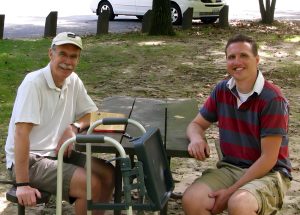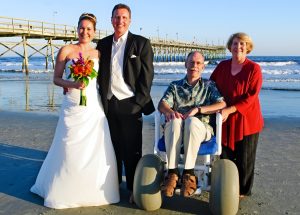Katie Meyer to Speak to VTCSOM Students.
The Virginia Tech Carilion School of Medicine (VTCSOM) is employing an innovative educational method known as Problem-Based Learning (PBL) to prepare its students for future careers. Through this approach, students interact directly with individuals living with conditions like Multiple Sclerosis (MS), gaining real-world perspectives on the diseases they will one day treat.
MS patient and advocate, Katie Meyer, will soon be sharing her experience with students in the program for the third year in a row. Katie, who was diagnosed with MS in 2013, has been a dedicated volunteer with the MS Alliance of VA (MSAV) since its founding and currently serves as a co-facilitator for our online MS Support Group Meetings. Katie hopes students will understand the individuality of this disease, “MS manifests differently in each person, and symptoms can change rapidly. Despite these challenges, those of us with MS must constantly advocate for ourselves – with insurance and pharmaceutical companies, employers, and sometimes even our own families who may not fully grasp the nature of this invisible illness. If our doctors can understand all of the moving parts that make up the MS patient, they can then give us better care.”
Dr. Kris Rau, PhD (Assistant Professor – Department of Basic Science Education at VTCSOM) was kind enough to explain to us in more depth what Problem Based Learning is and how it benefits students at VTCSOM.

Dr. Kris Rau, PhD
Dr. Rau – At VTCSOM, Problem-Based Learning (PBL) is a patient-focused approach to helping our first- and second-year medical students expand their knowledge of the essential basic science that they will need to know as physicians. A new case is presented each week, which they work on in small groups of seven students and one faculty facilitator. Throughout the week, our students build on the experience, progressing through the patient’s first visit to the doctor, to subsequent testing and diagnosis, to treatment and management, and concludes with an epilogue that summarizes the patient’s current condition. During this time, the students work together to research and present faculty-assigned learning objectives that focus not just on the basic science, but also on topics relating to psychosocial factors, health disparities, ethical considerations, quality and safety guidelines, health systems science, and interprofessionalism. To address self-identified gaps in their knowledge, the students also have the opportunity to design their own learning objectives. Through this process, they improve their critical thinking skills, clinical reasoning, and peer-to-peer teaching capabilities
MSAV – What feedback have you heard from students in regards to this program?
Dr. Rau – Students have consistently rated PBL as one of the primary strengths of our school. We regularly seek feedback from our students, and while the structure of the PBL week has changed over time based on that feedback, the one aspect that has not changed has been the wrap-up experience with the patient and physician at the end of each week. During their fourth year, students have the opportunity to take an educational elective, and many of them eagerly sign up to help facilitate the PBL groups, and write up new cases with our wrap-up patients. The past several years, we have also had former students who have completed their out-of-state residencies come back to the Roanoke Valley to practice medicine. These physicians frequently cite PBL as their favorite experience while at VTCSOM, and several of them have even served as our wrap-up doctor.
MSAV – Are students participating in this program still deciding the field of medicine they want to go into?
Dr. Rau – Some of our students come in with a clear vision of what type of doctor they want to become, but many do not. PBL offers a holistic experience where students really get to know the ins and outs of different fields of medicine. It helps to guide their choices of clinical rotations in their third and fourth years, and ultimately does factor into their chosen professional field.
MSAV – How do you choose the patients that are the feature/subject matter of the learning program?
Dr. Rau – The clinical topics that we base our weekly PBL program around usually relate to the basic science that our students are learning about in their regular classes and gross anatomy sessions. For instance, our multiple sclerosis case is used to complement the content that they are learning about in the classroom that week, which focuses on neural circuitry, molecular neurobiology, and signaling. Our students learn about how neural anatomy and physiology work in healthy situations, and are able to have a better understanding of what can happen when these systems do not work the way they should. Most patients who kindly offer their time to meet with our students are first approached by our wrap-up physician, who is often their primary care provider. Having guests like Katie is particularly impactful for our students, because she does such a terrific benefit to the MS community through her openness and honesty about what it is like to have the disease, the struggles that she has faced in her healthcare experience, and what our students can do to be the best future doctors that they can be for their patients.
MSAV – How long has Virginia Tech School of Medicine been utilizing this teaching method and why was it added to the curriculum?
Dr. Rau – VTCSOM was one of the first medical schools in the country to frame their student’s educational experience around PBL, and it has been one of the foundational cornerstones for our curriculum since VTCSOM opened its doors in 2010. Based on best teaching practices and learning theory, our founders felt the curriculum would greatly benefit from using this pedagogical model.
MSAV – How did Multiple Sclerosis come to be chosen as one of your PBL cases at VTCSOM?
Dr. Rau – Multiple sclerosis is of personal interest because my father-in-law, Dr. Keith Snavely, was diagnosed with Primary Progressive Multiple Sclerosis. He had a terrific career as a Professor of Political Science at Southern Illinois University (SIU), and had such a profound effect on his students and colleagues that they established a new chapter of the National Multiple Sclerosis Society in Carbondale, Illinois, as well as a scholarship at SIU in his honor. Upon diagnosis, he was an advocate for advancing research into diagnosis, therapeutic intervention, and finding a cure for Multiple Sclerosis. Beyond his professional career, he was such a genuinely kind person who was inspirational and creative. He unfortunately passed away in 2016 due to complications from Multiple Sclerosis, but I witnessed many of the challenges that he faced, as well as the challenges faced by my mother-in-law, who was his primary caretaker. When I was hired at VTCSOM, I felt that we needed to add Multiple Sclerosis as the focus of one of our PBL cases in his honor. Although Dr. Snavely was most certainly not defined by Multiple Sclerosis, he certainly provided an inspiration to continue his legacy and ensure that our students are aware of ways that they can help their patients. It is vital for our medical students to appreciate the challenges faced by their patients who have Multiple Sclerosis, and not be limited by what they read in textbooks or by their brief encounters with patients in clinical settings. Building empathy and compassion are characteristics that we want to instill in our students, and these face-to-face wrap-up sessions in PBL are excellent opportunities.

Dr. Rau and his Father-in-Law Dr. Keith Snavely

Dr. Rau on his wedding day with his Father-in-Law in his beach accessible wheelchair.


